
The standard circulating coinage of the United Kingdom, British Crown Dependencies and British Overseas Territories is denominated in pounds sterling, and, since the introduction of the two-pound coin in 1994, ranges in value from one penny to two pounds. Since decimalisation, on 15 February 1971, the pound has been divided into 100 (new) pence. Before decimalisation, twelve pence made a shilling, and twenty shillings made a pound. British coins are minted by the Royal Mint in Llantrisant, Wales. The Royal Mint also commissions the coins' designs. As of 14 October 2019, there were an estimated 29 billion coins circulating in the United Kingdom.

A penny is a coin or a unit of currency in various countries. Borrowed from the Carolingian denarius, it is usually the smallest denomination within a currency system. Presently, it is the formal name of the British penny (abbr. p) and the informal name of the American one cent coin (abbr. ¢) as well as the informal Irish designation of the 1 cent euro coin (abbr. c). It is the informal name of the cent unit of account in Canada, although one cent coins are no longer minted there. The name is also used in reference to various historical currencies also derived from the Carolingian system, such as the French denier and the German pfennig. It may also be informally used to refer to any similar smallest-denomination coin, such as the euro cent or Chinese fen.
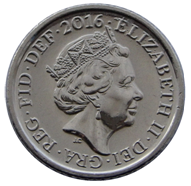
The British decimal five pence (5p) coin – often pronounced five pee – is a unit of currency equalling five one-hundredths of a pound sterling. Its obverse has featured the profile of Queen Elizabeth II since the coin’s introduction on 23 April 1968, replacing the shilling in preparation for decimalisation in 1971. It remained the same size as the one shilling coin, which also remained legal tender, until a smaller version was introduced in June 1990 with the older coins being withdrawn on 31 December 1990. Four different portraits of the Queen have been used, with the latest design by Jody Clark being introduced in 2015. The second and current reverse, featuring a segment of the Royal Shield, was introduced in 2008.

The British decimal two pence (2p) coin – often informally pronounced too pee – is a unit of currency equalling 2/100ths of a pound sterling. Its obverse has featured the profile of Queen Elizabeth II since the coin's introduction on 15 February 1971, the year British currency was decimalised. Four different portraits of the Queen have been used on the coin, with the latest design by Jody Clark being introduced in 2015. The second and current reverse, featuring a segment of the Royal Shield, was introduced in 2008.

The British decimal halfpenny coin was introduced in February 1971, at the time of decimalisation, and was worth one two-hundredth of a pound sterling. It was ignored in banking transactions, which were carried out in units of 1p.

The British threepence (3d) coin, usually simply known as a threepence, thruppence, or thruppenny bit, was a unit of currency equaling one eightieth of a pound sterling, or three old pence sterling. It was used in the United Kingdom, and earlier in Great Britain and England. Similar denominations were later used throughout the British Empire, notably in Australia, New Zealand, and South Africa.

The British crown, the successor to the English crown and the Scottish dollar, came into being with the Union of the kingdoms of England and Scotland in 1707. As with the English coin, its value was five shillings.
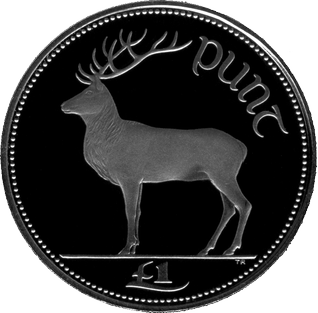
The Irish pound was the currency of Ireland until 2002. Its ISO 4217 code was IEP, and the usual notation was the prefix £. The Irish pound was replaced by the euro on 1 January 1999. Euro currency did not begin circulation until the beginning of 2002.

Decimal Day in the United Kingdom and in Ireland was the day on which each country decimalised its respective £sd currency of pounds, shillings, and pence.
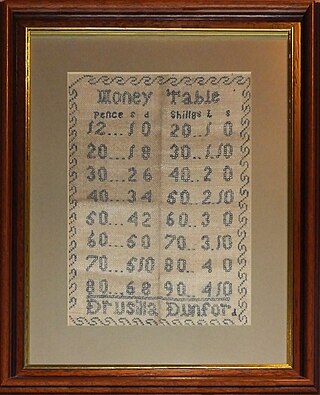
£sd is the popular name for the pre-decimal currencies once common throughout Europe, especially in the British Isles and hence in several countries of the British Empire and subsequently the Commonwealth. The abbreviation originates from the Latin currency denominations librae, solidi, and denarii. In the United Kingdom, these were referred to as pounds, shillings, and pence.

The commemorative British decimal twenty-five pence (25p) coin was issued in four designs between 1972 and 1981. These coins were a post-decimalisation continuation of the traditional crown, with the same value of a quarter of a pound sterling. Uniquely in British decimal coinage, the coins do not have their value stated on them. This is because previous crowns rarely did so. The British regular issue coin closest to the coin’s nominal value is the twenty pence coin.
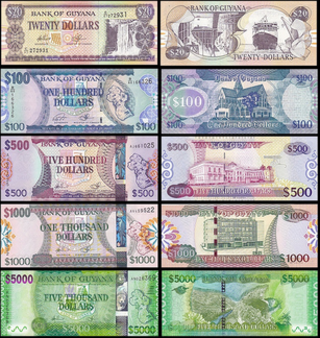
The Guyanese dollar has been the unit of account in Guyana since 29 January 1839. Originally it was intended as a transitional unit to facilitate the changeover from the Dutch guilder system of currency to the British pound sterling system. The Spanish dollar was already prevalent throughout the West Indies in general, and from 1839, the Spanish dollar unit operated in British Guiana in conjunction with British sterling coins at a standard conversion rate of one dollar for every four shillings and twopence. In 1951 the British sterling coinage was replaced with a new decimal coinage which was simultaneously introduced through all the British territories in the Eastern Caribbean. When sterling began to depreciate in the early 1970s, a switch to a US dollar peg became increasingly attractive as an anti-inflationary measure and the Eastern Caribbean Currency Authority made the switch in October 1975. The Guyanese dollar is normally abbreviated with the dollar sign $, or alternatively G$ to distinguish it from other dollar-denominated currencies.
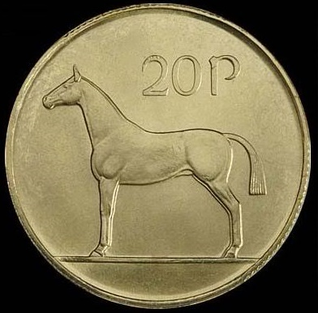
The twenty pence (20p) coin was a subdivision of the Irish pound. It was introduced on 30 October 1986. It was the first Irish decimal coin of a different size to the corresponding British coin, as the Irish pound had not been pegged to the British pound since 1979. Its last issue was in 2000, two years before Ireland withdrew its pound for the euro.

The sixpence, sometimes known as a tanner or sixpenny bit, is a coin that was worth six pence, equivalent to one-fortieth of a pound sterling, or half of a shilling. It was first minted in 1551, during the reign of Edward VI, and circulated until 1980. Following decimalisation in 1971 it had a value of 2 1⁄2 new pence. The coin was made from silver from its introduction in 1551 until 1947, and thereafter in cupronickel.
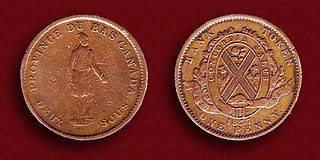
The pound was the unit of account for currency of the Canadas until 1858. It was subdivided into 20 shillings (s), each of 12 pence (d). In Lower Canada, the sou was used, worth 1⁄2 penny. Although the pounds, shillings, and pence accounting system had its origins in the British pound sterling, the Canadian pound was never formally linked to the British currency.
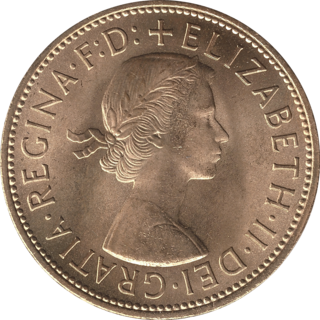
The pre-decimal penny (1d) was a coin worth 1/240 of a pound sterling, or one twelfth of a shilling. Its symbol was d, from the Roman denarius. It was a continuation of the earlier English penny, and in Scotland it had the same monetary value as one pre-1707 Scottish shilling. The penny was originally minted in silver, but from the late 18th century it was minted in copper, and then after 1860 in bronze.

The pre-decimal twopence (2d) was a coin worth one one-hundred-and-twentieth of a pound sterling, or two pence. It was a short-lived denomination in copper, being minted in only 1797 by Matthew Boulton's Soho Mint.

The pre-decimal fourpence (4d), sometimes known as a groat or fourpenny bit, was a coin worth one sixtieth of a pound sterling, or four pence. The coin was also known as a joey after the MP Joseph Hume, who spoke in favour of its introduction. It was a revival of the pre-Union coin.
Tuppence, sometimes abbreviated to “Tuppy” is a diminutive or nickname, often given to a young child. It may relate to the smallness of the coin - being a very small coin used as Maundy money after the 1820s. It may also relate to its relative rarity, being produced initially in 1797 as a very large “cartwheel” copper coin and thereafter only as Maundy money as a rare and very small silver coin, largely given away only by the monarch. Only a few thousand are produced each year by the Royal Mint. See twopence.

















